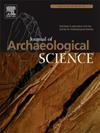Using intestinal parasites to identify the utilization of archaeological structures: A 12th-13th century sewer systems from an Islamic funduq (Murcia, Spain)
IF 2.5
1区 地球科学
Q1 ANTHROPOLOGY
引用次数: 0
Abstract
The discovery of specific parasites in archaeological contexts provides unique insights into the hygiene, sanitation, and socioeconomic dynamics of ancient populations, as well as their patterns of mobility. Paleoparasitological evidence offers a window into the spread of infections across different regions and time periods. This investigation leveraged paleoparasitology to explore the utilization of archaeological structures, specifically the water drainage system of a 12th-13th century funduq in the ancient Islamic city of Murcia, Spain. Through a systematic analysis, parasitic findings were compared with archaeological evidence, revealing a strong correlation between the presence of roundworm and whipworm eggs in wastewater channels and their functional role. In contrast, the absence of parasitic eggs in the clean water system further confirmed the distinct purposes of the pipes. This approach confirms paleoparasitology as a powerful tool for interpreting the use of ancient infrastructure.
利用肠道寄生虫来识别考古结构的用途:来自伊斯兰基金的12 -13世纪下水道系统(西班牙穆尔西亚)
在考古背景下发现的特定寄生虫为了解古代人口的卫生、环境卫生和社会经济动态以及他们的流动模式提供了独特的见解。古寄生虫学证据为了解感染在不同地区和时期的传播提供了一个窗口。这项研究利用古寄生虫学来探索考古结构的利用,特别是西班牙穆尔西亚古伊斯兰城市12 -13世纪地基的排水系统。通过系统分析,寄生虫发现与考古证据进行了比较,揭示了废水通道中蛔虫和鞭虫卵的存在与它们的功能作用之间存在很强的相关性。相比之下,净水系统中没有寄生虫卵进一步证实了管道的独特用途。这种方法证实了古寄生虫学是解释古代基础设施使用的有力工具。
本文章由计算机程序翻译,如有差异,请以英文原文为准。
求助全文
约1分钟内获得全文
求助全文
来源期刊

Journal of Archaeological Science
地学-地球科学综合
CiteScore
6.10
自引率
7.10%
发文量
112
审稿时长
49 days
期刊介绍:
The Journal of Archaeological Science is aimed at archaeologists and scientists with particular interests in advancing the development and application of scientific techniques and methodologies to all areas of archaeology. This established monthly journal publishes focus articles, original research papers and major review articles, of wide archaeological significance. The journal provides an international forum for archaeologists and scientists from widely different scientific backgrounds who share a common interest in developing and applying scientific methods to inform major debates through improving the quality and reliability of scientific information derived from archaeological research.
 求助内容:
求助内容: 应助结果提醒方式:
应助结果提醒方式:


